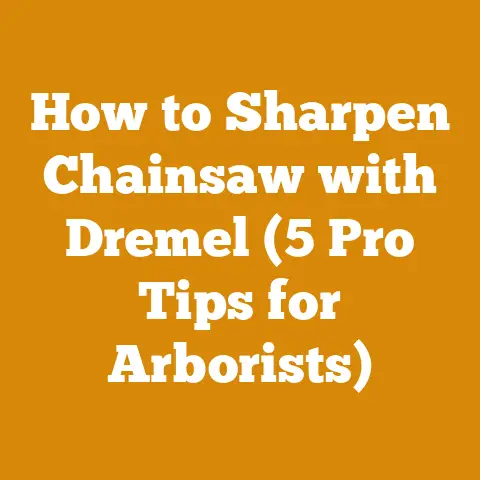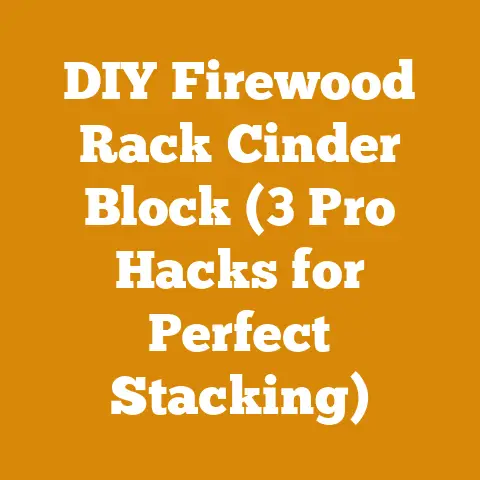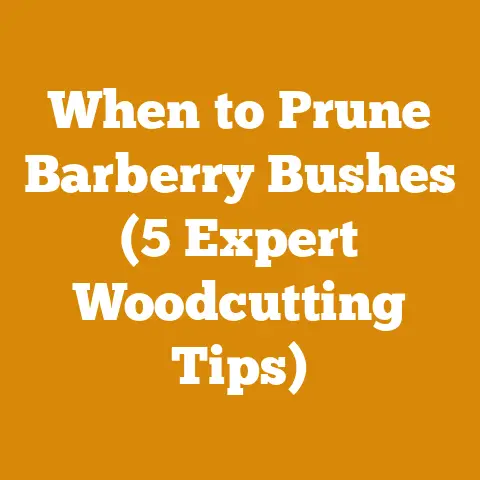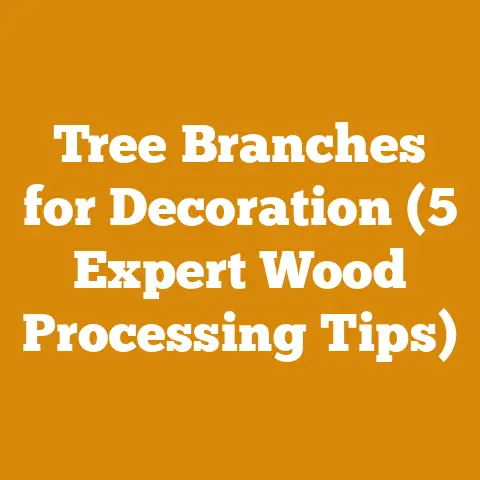DIY Pole Shed: Build a Durable Pole Barn (Creosote Tips & Foundation)
Understanding Pole Shed Construction
Pole shed construction, also known as post-frame construction, is a building method that utilizes large, pressure-treated posts embedded directly into the ground to provide structural support. Unlike traditional stick-frame construction that relies on a continuous foundation, pole sheds are faster to build and generally more affordable.
The key advantages of pole shed construction include:
- Cost-effectiveness: Reduced material costs and labor requirements compared to traditional methods.
- Speed of construction: Faster build times due to simplified foundation and framing processes.
- Versatility: Adaptable to various sizes, designs, and uses.
- Durability: When properly constructed with pressure-treated lumber and appropriate techniques, pole sheds can withstand harsh weather conditions.
Planning Your Pole Shed Project
Proper planning is essential for a successful pole shed build. Before you even think about picking up a hammer, take the time to carefully consider the following:
Defining Your Needs and Purpose
The first step is to clearly define the purpose of your pole shed. This will influence the size, design, and features you incorporate.
- Storage: Will it be for storing equipment, vehicles, or materials?
- Workshop: Will you need ample space for tools, machinery, and workbenches?
- Animal Shelter: How many animals will it house, and what specific needs do they have?
- Multi-Purpose: Will it serve multiple functions?
Once you have a clear understanding of your needs, you can start to determine the appropriate size and layout for your pole shed. I always recommend erring on the side of slightly larger than you initially think you need. You’ll likely find more uses for the space than you anticipate.
Site Selection and Preparation
Choosing the right location for your pole shed is crucial. Consider these factors:
- Accessibility: Ensure easy access for vehicles and equipment. I once built a shed in a location that seemed perfect at first, only to realize hauling materials in was a nightmare.
- Drainage: Select a well-drained area to prevent water damage. Poor drainage can lead to premature rotting of the posts.
- Soil Conditions: Assess the soil type and stability. Sandy or loose soil may require additional reinforcement.
- Zoning Regulations and Permits: Check with your local authorities regarding building codes, zoning regulations, and permit requirements. This is a step you absolutely cannot skip. Failure to obtain the necessary permits can result in fines or even having to tear down your structure.
- Utilities: Consider the proximity to utilities like electricity and water if needed.
Once you’ve selected your site, you’ll need to prepare it by clearing vegetation, leveling the ground, and ensuring proper drainage. I often use a laser level to ensure the site is perfectly level, which makes the subsequent construction process much easier.
Design and Dimensions
With your needs defined and site selected, it’s time to create a detailed design for your pole shed. Consider the following:
- Overall Dimensions: Determine the length, width, and height of your pole shed.
- Post Spacing: Standard post spacing is typically 8-12 feet. Closer spacing provides greater structural strength. I usually aim for 10-foot spacing for most of my projects.
- Roof Pitch: Choose a roof pitch that complements your aesthetic preferences and local weather conditions. A steeper pitch sheds snow and rain more effectively.
- Door and Window Placement: Plan the location and size of doors and windows for optimal access and ventilation.
- Material Selection: Choose durable and weather-resistant materials for the posts, framing, roofing, and siding.
I highly recommend creating detailed blueprints or using a pole shed design software. This will help you visualize the final product and ensure accurate material calculations.
Lumber and Fasteners
- Pressure-Treated Posts: Typically 6×6 or 8×8 posts, depending on the size and load requirements of your shed. Ensure they are properly treated for ground contact.
- Framing Lumber: 2x4s, 2x6s, or 2x8s for wall girts, roof purlins, and other framing components.
- Roofing Material: Metal roofing is a popular choice due to its durability and longevity. Asphalt shingles are another option, but they require more maintenance.
- Siding Material: Wood siding, metal siding, or composite siding. Choose a material that is weather-resistant and complements your aesthetic preferences.
- Fasteners: Galvanized nails, screws, and bolts. Use appropriate fasteners for each application to prevent corrosion.
Tools
- Post Hole Digger or Auger: For digging the post holes.
- Level: For ensuring posts are plumb and framing is level.
- Measuring Tape: For accurate measurements.
- Circular Saw or Chainsaw: For cutting lumber.
- Drill and Impact Driver: For driving screws and bolts.
- Hammer: For driving nails.
- Wrench Set: For tightening bolts.
- Safety Glasses and Gloves: For personal protection.
- Ladder: For reaching high areas.
- Concrete Mix: For setting the posts in the ground.
I always recommend investing in high-quality tools. They will make the job easier and last longer. A good chainsaw is indispensable for any wood processing project.
Creosote Treatment: Protecting Your Posts
Creosote is a wood preservative that protects against rot, decay, and insect infestation. While it’s not as widely used as it once was due to environmental concerns, it remains an effective treatment for posts that will be in direct contact with the ground.
Important Note: Creosote is a hazardous material. Always wear appropriate protective gear (gloves, respirator, eye protection) when handling it and follow all safety precautions. Check your local regulations regarding the use of creosote.
Applying Creosote
If you choose to use creosote, follow these steps:
- Preparation: Clean the posts thoroughly and allow them to dry completely.
- Application: Apply creosote liberally to the portion of the post that will be buried in the ground, as well as a few feet above the ground line. You can use a brush, roller, or dipping method.
- Drying: Allow the creosote to dry completely before installing the posts. This may take several days.
Alternatives to Creosote:
If you’re concerned about the environmental impact of creosote, consider using alternative wood preservatives such as:
- Copper Azole (CA): A water-based preservative that is effective against rot and insects.
- Alkaline Copper Quaternary (ACQ): Another water-based preservative with similar properties to CA.
- Borate: A naturally occurring mineral that is effective against insects and fungi.
These alternatives are generally considered safer for the environment and are readily available at most lumber yards.
Foundation Considerations
While pole sheds don’t require a traditional continuous foundation, proper foundation preparation is crucial for stability and longevity.
Post Hole Depth and Diameter
The depth and diameter of the post holes will depend on the size of your pole shed and the soil conditions. As a general rule, the post holes should be at least 4 feet deep and 12 inches in diameter. In areas with frost heave, the post holes should extend below the frost line.
I always recommend consulting with a local building inspector or engineer to determine the appropriate post hole depth for your specific location.
Setting the Posts
- Dig the Post Holes: Use a post hole digger or auger to dig the post holes to the required depth and diameter.
- Position the Posts: Place the posts in the holes, ensuring they are plumb and aligned according to your design.
- Backfill with Concrete: Backfill the post holes with concrete mix, ensuring the concrete is compacted around the posts. This will provide a solid foundation and prevent the posts from shifting.
- Level the Posts: Use a level to ensure the posts are perfectly plumb. You can use temporary bracing to hold the posts in place while the concrete sets.
Alternative Foundation Options
- Concrete Piers: Instead of setting the posts directly in the ground, you can pour concrete piers and attach the posts to the piers using metal brackets. This provides a more stable foundation and prevents the posts from coming into direct contact with the soil.
- Gravel Base: Backfilling the post holes with gravel instead of concrete can improve drainage and prevent water from accumulating around the posts. However, this method may not be suitable for all soil conditions.
Building the Frame
With the posts set and the foundation in place, it’s time to start building the frame of your pole shed.
Installing Wall Girts
Wall girts are horizontal framing members that are attached to the posts to provide support for the siding.
- Attach the Girts: Attach the girts to the posts using screws or bolts. The spacing between the girts will depend on the type of siding you are using.
- Ensure Level: Use a level to ensure the girts are perfectly level.
Constructing the Roof Frame
The roof frame consists of rafters, purlins, and other structural members that support the roofing material.
- Install Rafters: Attach the rafters to the posts, ensuring they are properly spaced and aligned.
- Install Purlins: Attach the purlins to the rafters. Purlins are horizontal framing members that provide support for the roofing material.
- Ensure Proper Pitch: Make sure the roof frame has the correct pitch to effectively shed water and snow.
Installing Roofing and Siding
With the frame complete, it’s time to install the roofing and siding.
Roofing Installation
- Prepare the Roof Deck: Ensure the roof deck is clean and free of debris.
- Install Underlayment: Install a layer of roofing underlayment to protect the roof deck from moisture.
- Install Roofing Material: Install the roofing material according to the manufacturer’s instructions. Overlap the roofing material properly to prevent leaks.
Siding Installation
- Prepare the Wall Surface: Ensure the wall surface is clean and free of debris.
- Install Siding Material: Install the siding material according to the manufacturer’s instructions. Overlap the siding material properly to prevent water from penetrating the walls.
Doors and Windows
Installing doors and windows will provide access and ventilation to your pole shed.
Door Installation
- Frame the Door Opening: Frame the door opening using lumber.
- Install the Door Frame: Install the door frame into the opening.
- Hang the Door: Hang the door in the frame, ensuring it swings freely.
Window Installation
- Frame the Window Opening: Frame the window opening using lumber.
- Install the Window Frame: Install the window frame into the opening.
- Install the Window: Install the window into the frame, ensuring it is properly sealed.
Interior Finishing (Optional)
If you plan to use your pole shed as a workshop or living space, you may want to consider finishing the interior.
- Insulation: Insulate the walls and roof to improve energy efficiency.
- Electrical Wiring: Install electrical wiring for lighting and power outlets.
- Wall Paneling: Install wall paneling to create a finished interior.
- Flooring: Install flooring to create a comfortable and durable surface.
Safety Considerations
Safety should always be a top priority when building a pole shed.
- Wear Protective Gear: Always wear safety glasses, gloves, and other protective gear when working with tools and materials.
- Use Ladders Safely: Use ladders properly and ensure they are stable.
- Be Aware of Overhead Hazards: Be aware of overhead hazards such as power lines and tree branches.
- Work with a Partner: If possible, work with a partner to assist with lifting and handling heavy materials.
- Take Breaks: Take frequent breaks to avoid fatigue.
Maintenance and Upkeep
Proper maintenance is essential for ensuring the longevity of your pole shed.
- Inspect Regularly: Inspect your pole shed regularly for signs of damage or wear.
- Repair Damage Promptly: Repair any damage promptly to prevent it from worsening.
- Clean Regularly: Clean your pole shed regularly to remove dirt, debris, and pests.
- Re-treat Wood: Re-treat the wood with preservative as needed to protect it from rot and insects.
Case Study: My Own Pole Shed Project
I built a 24×36 pole shed on my property a few years ago to serve as a workshop and storage area. I opted for 6×6 pressure-treated posts spaced 10 feet apart. I used metal roofing and siding for durability and low maintenance.
One of the biggest challenges I faced was leveling the site. The ground had a significant slope, so I had to bring in fill dirt and use a laser level to create a perfectly level surface. It took a couple of days, but it was well worth the effort.
I also decided to install a concrete slab floor, which made a huge difference in the usability of the space. It provides a clean and level surface for working and storing equipment.
Overall, the project took me about three weeks to complete, working on weekends and evenings. It was a lot of hard work, but I’m extremely happy with the results. My pole shed has been a valuable addition to my property, providing ample space for my woodworking projects and storage needs.
Common Mistakes to Avoid
- Skimping on Materials: Using low-quality materials can compromise the structural integrity of your pole shed.
- Poor Site Preparation: Failing to properly prepare the site can lead to drainage problems and foundation issues.
- Inadequate Post Hole Depth: Not digging the post holes deep enough can result in instability.
- Improper Fastening: Using the wrong type of fasteners or not fastening them securely can weaken the frame.
- Ignoring Building Codes: Failing to comply with local building codes can result in fines or having to tear down your structure.
Troubleshooting Common Issues
- Leaking Roof: Check for damaged or missing roofing material and repair or replace as needed.
- Warped Siding: Replace warped siding to prevent water damage.
- Rotting Posts: Treat the posts with preservative to prevent further rot. In severe cases, you may need to replace the posts.
- Sagging Roof: Add additional support to the roof frame to prevent sagging.
Cost Breakdown
The cost of building a pole shed will vary depending on the size, materials, and features you choose. Here’s a rough estimate:
- Materials: \$5,000 – \$15,000
- Tools: \$500 – \$2,000 (if you need to purchase new tools)
- Labor: \$0 (if you do it yourself) or \$2,000 – \$5,000 (if you hire a contractor)
- Permits: \$100 – \$500
Total Cost: \$5,600 – \$22,500
Conclusion
Building a DIY pole shed is a challenging but rewarding project. By following the steps outlined in this guide and paying attention to detail, you can build a durable and versatile structure that will serve your needs for years to come. Remember to prioritize safety, obtain the necessary permits, and choose high-quality materials. With careful planning and execution, you can create a pole shed that is both functional and aesthetically pleasing. I hope my experiences and insights shared here will help you bring your vision to life. Good luck with your project!






